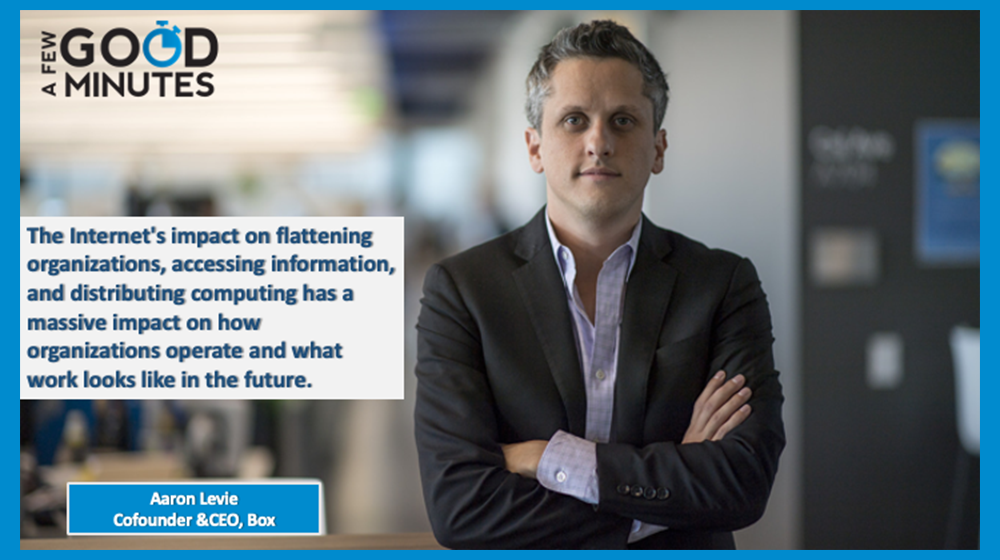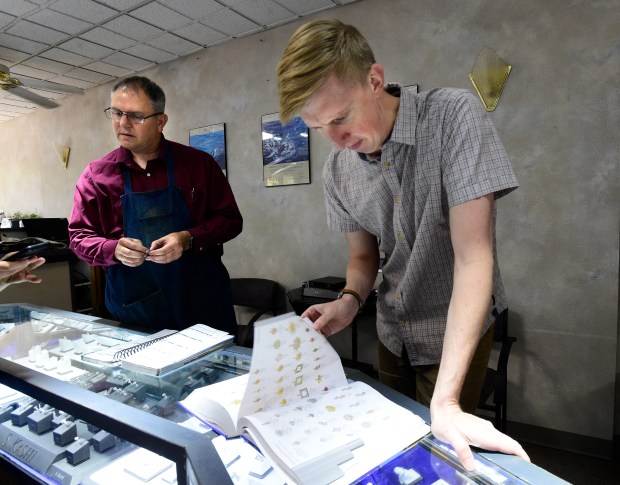[ad_1]
Over fifteen years ago I hosted a weekly radio show here in Atlanta called Technology for Business Sake. One of my earliest guests was Aaron Levie, co-founder and CEO of this online storage company Box.com. I remember having a fun conversation with him as we talked about a number of things, from entrepreneurship to what Box did to whatever came to mind back then. I even remember thinking why would anybody want to store their data files in the cloud…. Yeah, I have to admit to thinking that. But I know I wasn’t the only one!
Anyways, as great as that conversation was, and as successful as I watched Aaron and Box become from afar (Box is now publicly traded and has move way past just providing online storage to become a collaborative platform used by thousands of businesses), we haven’t talked once since our initial conversation on my old radio show 14+ years ago. It goes without saying a lot has happened since then, and I was so glad to have caught up with Aaron recently for a LinkedIn Live conversation to talk about a number of different items, including how the future of work is being shaped by everything from the Internet, the metaverse and other recently emerging technologies.
Below is an edited transcript from a portion of our conversation. Click on the embedded SoundCloud player to hear the full conversation.
Impact of Pandemic on the Future of Work
Aaron Levie: We were really trying to pitch cloud computing as this revolution in how software would be delivered and completely change how we would work with our information and our data, and we’d be able to work from anywhere. And it’s very unfortunate, but it ultimately took, in some respects, the global pandemic the past couple of years for people to see that this actually is a complete transformation in how we can work, where we can work from, who we can work with. And it’s obviously very unfortunate that that’s really what I think caused that to happen on a universal level, but it also became an opportunity for many to revisit their strategies around work and the role of computing and work. And now, here we are. We’re very much in this new flexible hybrid way of working, and software is clearly going to be the kind of basis in which we manage all of that work in the future.
Brent Leary: There’s a lot of hype around digital transformation and the future of work. What things aren’t getting the hype but are important for us to be thinking about?
Aaron Levie: One of the most exciting things about technology is the fact that there’s so many different conversations. You can be talking about the metaverse and virtual reality. You can still be talking about cloud computing. We can talk about artificial intelligence, and what’s the future of autonomous systems, and manufacturing, and cars. There’s still 3D printing, and manufacturing space is still alive and well. So there’s an amazing amount of innovation happening, but choosing, in particular, which trends to focus on becomes very, very important for any kind of business.
I think the things we get most fascinated by is, weirdly, the stuff we founded the company on. And they’re just trends that continue to be alive and well in this industry. I’ll just enumerate them super quickly.
First, we know for a fact that over time computing and computers are going to get faster and cheaper. What that leads to is ubiquitous computing everywhere. And if you just compare how many computers you have in your life today, probably I’m sure on your end, you still had plenty 15 years ago, but today, most of us have probably two to three to five times more computers in our lives than we did 15 years ago between our watches, our iPads, our phones, our laptops. And at any given time… Right now, literally in front of me, I have four different computers that I can interact with, including what now is obviously a phone, which is now a computer. Going back 15 years ago, that would’ve been one, and it would’ve been largely immobile as a desktop PC. So we know that computing is going to become more ubiquitous.
We know the internet is certainly becoming more ubiquitous and much faster. We know the cost of storage infrastructure and the actual infrastructure that runs our systems are going to get cheaper and higher in performance. What does that all mean? More computers, more storage, faster internet, better GPUs. We’re going to become even more connected over time. And that’s going to have a massive effect in global commerce, in how businesses are run, in how we operate our organizations. And I think the daily implications of that, certainly we’ve seen in the past couple of years in terms of hybrid work and being able to work in this virtual-first way, I think that continues to persist.
Evolution of Collaboration
I think it’s going to change how companies continue to collaborate and work together. We’re going to start to see more and more open boundaries between teams and organizations. If you go back 30, 50 years ago, most companies were vertically integrated. They ran all of their supply chain themselves. They hired all the people inside their organization themselves. They had very strict hierarchies as organizations. And if you look at the future, things are going to be much more fluid, much more open. Companies are going to be increasingly distributed and need to work with colleagues and counterparts much more in a global network. And so I think the Internet’s impact on flattening organizations and access to information and distributing computing has a massive impact on, then, how organizations operate, how companies run and what work looks like in the future. And just the fact that we can do this video conversation distributed to anybody is a great example of, then, the power of these trends over the past couple of decades.
Brent Leary: We heard a lot about digital transformation before the pandemic. We’ve definitely heard a lot about it during the pandemic. What’s been the impact of the pandemic on the definition of digital transformation, and maybe even from a collaborative standpoint? And as you said, it seems like organizational structures are flattening. And does that mean that the definition of collaboration changes because it’s not just employee-to-employee or employee-to-management, but it’s now organizations and the other organizations that make up their ecosystem up and down the supply chain?
Aaron Levie: Well, 100 percent. I think one of the most interesting things has been in watching business in the past, at least from our purview at Box for the past decade and a half is you always have had this tension, which is the larger a company gets, the slower it becomes. The more bureaucracy that gets created, the harder it is to execute, the harder it is to innovate. And conversely, we’ve seen that small companies end up being much more disruptive, because they can move much quicker. They can be much more agile, they can be more nimble. And that’s why I think small businesses and startups are incredibly exciting, because they can always move much faster than large organizations. And large organizations have always been trying to figure out what’s that secret sauce, what’s that magic of a small organization, but we’ve actually known it all along, which is it’s the fact that you can get five or 10 people in a room, and that’s the entire company, and you can make a decision, and then go execute on it.
And so here’s what’s remarkable about, I think, being two decades into the 21st century. Small businesses previously have not had access to the resources of a large company. So a small business didn’t have the ability to do commerce on a global scale. They didn’t have the ability to do supply chains on a global scale. They didn’t have access to the same infrastructure that a large powerhouse might, but cloud computing and then the subsequent innovations all led to that happening. So you can be a small business, and you can leverage Shopify and have the same eCommerce infrastructure as Amazon for all intents and purposes. You can use online advertising and have the same resources as a major retailer that has a massive multi-hundred or multi-thousand person marketing team in house.
You can go to Amazon Web Services and leverage cloud infrastructure that previously, only the largest companies in the world like JP Morgan would have been able to bill out themselves. You can leverage products like Slack or Box or Atlassian or Zendesk and have applications to power your business in a way that, 20 years ago, you would not have had this sort of leading technology as a small business, because you couldn’t have afforded to bill it all out yourselves. So what’s amazing is that well into the 21st century, small businesses have the distribution, the supply chain, the commerce benefits and the infrastructure and software benefits of a large enterprise. So that’s this pretty amazing flattening of access to technology, and we’ve seen the incredible benefits of that. Everybody knows somebody who started a company because of Shopify, and all of a sudden, they’re in some business market that you never would’ve imagined before.
I have a friend who sells balloons online, and it’s like you would never have been able to imagine a balloon company… An online balloon company 10 years ago wouldn’t have made any sense. And this is a real meaningful business at scale. And so we’ve seen that dynamic where now we have the distributed nature of innovation and commerce that now lets any business, whether you’re one person or 10 or 20 people as a small business, and you can now scale globally. Okay. That’s amazing.
But there’s another amazing trend, which is back to the bureaucracy, the slow down of organizations. We’ve seen an equal trend, which is now the big companies, because of the openness of software, because of the distributed nature sure of work, the big companies are also becoming much more agile. And because when you throw in something like Slack into a large enterprise, it actually allows that large enterprise to start to operate like a startup again, because you can actually get everybody on the same page in a way that was not possible before that type of technology. So instantly, you can have a company of 500 or 5,000 employees that can begin to actually operate with the agility of those smaller companies. And so what technology is now allowing us to do is it’s letting the big companies operate smaller, and it’s letting the small companies operate at a scale and with the leverage and the infrastructure that was never possible before, like a big company. And I think this is an incredible equalizer in innovation, in access to talent, in commerce. And it does mean you have to be better than ever before competitively. You have to be able to make sure that your organization is leveraging all of the benefits of that scale and of the internet to take advantage of it.
The ultimate arbiter of all of this are consumers and customers. And I think this is the best time ever to be a customer on the internet, because you’ve got the big companies that want to innovate for you, and they’re innovating faster than ever before. And you’ve got the small companies that now can deliver to you in a way that wasn’t possible before. And so it’s ultimately a win for the world in terms of being able to actually get all of this innovation delivered to us. And that’s something that I get pretty excited about.
Collaboration – Art or Science?
Brent Leary: Has the advances in technology and communications made collaboration more art than science?
Aaron Levie: It’s an interesting way to think about it, which is how did a company like Ford or GM or or Procter & Gamble or G.E. get really, really good at what it does over 100 years? And it’s really through I mean, clearly incredible innovation from a product standpoint, but it’s also through very, very effective execution of process at scale. If you think about Procter Gamble, they have to make billions of products, I don’t know, a month for us as consumers, and the only way you can do that so that where we get like the same soap every single time is through being just amazing at process execution. And that’s obviously led to Six Sigma and these very, very, structured, rigorous processes in large organizations. Well, what that also lead to is a high degree of stagnancy.
It leads to a bit of slowdown in execution, because there’s a tension, which is the more innovation you get, the more that’s going to change your process. And the process is what lets you achieve results at scale if you’re one of these big industrial incumbents. So that was the sort of science of management for largely the past hundred years is how do you manage your organization to be able to go and deliver physical things at scale globally and all of a sudden we’re now in this digital world where it’s actually not about sort of always delivering physical things at scale to billions of people. It’s about being able to quickly respond to new market trends, be able to get new ideas that turn into products very quickly, often sort of fully delivering a digital experience if you’re in if you’re in the media industry, you know, it’s sort of less of a reliance on shipping physical films and movie theaters and much more of a reliance on getting us to download an app and consume that content directly.
So we moved from this world of only physical things and the management of delivering those physical things to now many, many more digital things and physical things, but in markets that are much more dynamic. And so the companies that succeed in the future are going to be those that are able to get the best ideas out of their employees, that are able to move much more quickly and in a much more agile way to respond to market trends.
There’s a technology digital capability to enable that. We need tools like modern software to help you run your business. But then there’s a management science, social dynamic, which is how do you collaborate as an organization? How do you ensure that the best ideas are filtering through the decision makers?
How do you ensure that you can respond in a very nimble way to a market trend? These are things that you can’t build up a scientific system around. It’s much more organic. And it means that organizations are going to have to master that ability to collaborate in new ways. And we’re only in the early days of what that even looks like.
READ MORE:
This is part of the One-on-One Interview series with thought leaders. The transcript has been edited for publication. If it’s an audio or video interview, click on the embedded player above, or subscribe via iTunes or via Stitcher.
[ad_2]
Source link




